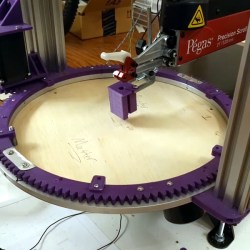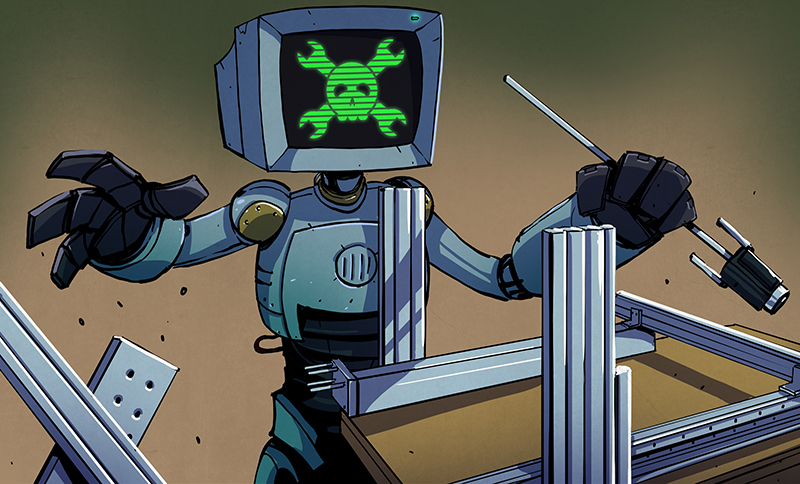I was enchanted by a failed project this week. [Andrew Consroe]’s CNC scroll saw doesn’t work yet, but the emphasis is on the word “yet”. Heck, even when it does work, it might not make sense, but that’s not the point anyway.

A scroll saw table has a vertical reciprocating blade perpendicular to a table, a lot like a band saw but with a shorter blade. You push the wood sheet to be cut into the blade, and because it’s thin, you can twist and turn all sorts of interesting jigsaw-puzzle shapes. [Andrew] automated this with an X-Y gantry and an innovative geared rotating ring, needed to keep the wood fed into the cutting edge of the blade.
It’s a crazy contraption, and a difficult and unique movement planning problem, and watching it move in the video is a joy. But it’s not working either: errors in the motion add up over a cut, and he’s ended up snapping a blade on every piece. And this is version three of the device!
But here comes the inspiration. First, the only reason he’s filming this is to keep a log of how the project looked at this phase — he’s already planning out the next one. Second, this is the soul of learning by doing. You don’t learn anything unless you’re trying something new.
And finally, [Andrew]’s project reminds me of why I love machine builds in the age of rapid prototyping. Blazing through three entirely different machines cost him essentially nothing. Tearing apart version one left him with the same stepper motors, aluminum extrusions, and electronics as when he started out. Except that he now knew so much more about his particular problem space. Now he’s ready to go again.
So if you’re at all robotically inclined, but you’re looking at the cost of motors, belts, bearings, and steel, don’t think of it as an expense for this project, but for years’ worth of iterations, and maybe even fully different machines.
Just be sure to take [Andrew]’s lead and get it down and documented before you take it apart! Heck, send it in to Hackaday and it’ll live forever.
















A sawblade has a maximum turning angle defined by the set of the teeth and the depth of the blade. Trying to go around tight corners will bend the blade and offset the next cut, and eventually snap it.
The software needs to take that into account and plan the cuts with wider sweeping curves, or back up and cut a relief for the blade to turn.
Jeweler’s saws, which are very closely related to these, have standard directional steel teeth but rounded backs. You can make what looks like a ninety degree turn by slowly rotating the material in place while you continuing sawing up and down, and when you get to your new angle, off you go. There are obviously cut-all-direction abrasive saws and cable saws, but the nice thing about a jeweler’s saw is you can get them in ludicrously narrow sizes. 0.15mm/6 mil thickness jeweler’s saw blades are cheap and readily available. They’re delicate, but they last a very long time if carefully treated.
And then there are wire saws which cut in 3very direction.
https://hackaday.com/2020/06/04/cnc-scroll-saw-makes-promising-first-cuts/
I’d like to see a version of this with a tilting table. If you cut at the right angle you cancel out your kerf and make a shape where the bottom of the cutout section is an exact fit for the top of the hole you just cut out. Jewelers have used this for making very complex punches for thin sheets of soft metal. It also has applications in multimetal inlay.
Huh, I don’t know what use this would be but if you tilted it a bit further you could make the spring equivalent of a diode: a spiral spring that only displaces in one direction.
This is the kind of machine action he needs to duplicate. https://www.youtube.com/watch?v=5A0vKA8PiXQ
What makes you say that?
There are “wire saws”, used when camping, that don’t have a preferred direction. The “blade” is round. Might one of these, or a special variant of one, be useful here ?